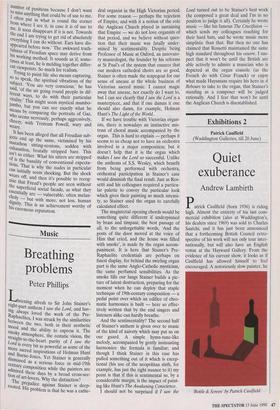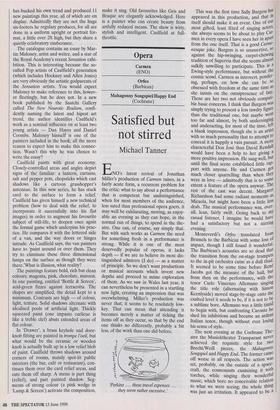Exhibitions 2
Patrick Caulfield
(Waddington Galleries, till 20 June)
Quiet exuberance
Andrew Lambirth
Patrick Caulfield (born 1936) is riding high. Almost the entirety of his last com- mercial exhibition (also at Waddington's, his dealers since 1969) was sold to Charles Saatchi, and it has just been announced that a forthcoming British Council retro- spective of his work will not only tour inter- nationally, but will also have an English venue at the Hayward Gallery. From the evidence of his current show, it looks as if Caulfield has allowed himself to feel encouraged. A notoriously slow painter, he Bottle & Screen' by Patrick Caulfield has bucked his own trend and produced 11 new paintings this year, all of which are on display. Admittedly they are not the huge six-footers he regulary produces, for all are done in a uniform upright or portrait for- mat, a little over 2ft high, but they share a quietly celebratory exuberance.
The catalogue contains an essay by Mar- tin Maloney, artist and writer, and a star of the Royal Academy's recent Sensation exhi bition. This is interesting because the so- called Pop artists of Caulfield's generation (which includes Hockney and Allen Jones) are very obviously the artistic godparents of the Sensation artists. You would expect Maloney to make reference to this, howev- er fleetingly, but he does not. In a new book published by the Saatchi Gallery called The New Neurotic Realism, confi- dently naming the latest and hipest art trend, the author identifies Caulfield's work as a seminal influence on at least two young artists — Dan Hayes and Daniel Coombs. Maloney himself is one of the painters included in the book; all the more reason to expect him to make this connec- tion. Wasn't this why he was chosen to write the essay?
Caulfield paints with great economy. Closely-controlled areas and angles depict signs of the familiar: a lantern, curtains, salt and pepper pots, chopsticks which cast shadows like a cartoon grasshopper's antennae. In this new series, he has stuck card to the surface to form a relief. • Caulfield has given himself a new technical problem (how to deal with the relief, to incorporate it successfully into his flat images) in order to augment his favourite subject of still-life, to deepen once again the formal game which underpins his prac- tice. He compares it with the lettered side of a van, and the way doors or hinges intrude. As Caulfield says, the van painters have to 'paint around or over them. They try to eliminate these three dimensional lumps on the surface as though they were there.'What is illusion, what reality?
The paintings feature bold, rich but clean colours: magenta, pink, chocolate, maroon. In one painting, entitled 'Bottle & Screen', acid-green fizzes against terracotta. The shapes are simplified, the detail kept to a minimum. Contrasts are high — of colour, light, texture. Solid shadows alternate with idealised pools of artificial light. Thickly squeezed paint (one impasto curlicue is like a treble clef) abuts extended areas of flat colour.
In 'Drawer', a brass keyhole and door- knob fitting are painted in trompe l'oeil, but what would be the ceramic or wooden knob is actually built up in a low relief blob of paint. Caulfield throws shadows around corners of rooms, mainly spot-lit public interiors (the bar, café or restaurant), con- tinues them over the card relief areas, and cuts them off sharp. A menu is part thing (relief), and part painted shadow. Seg- ments of strong colour (a pink wedge in `Lamp & Screen') activate the composition, make it sing. Old favourites like Gris and Braque are elegantly acknowledged. Here is a painter who can create beauty from artfully reduced means. The show is witty, stylish and intelligent. Caulfield at full- throttle.



































































 Previous page
Previous page